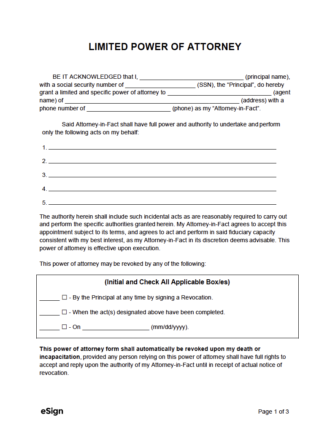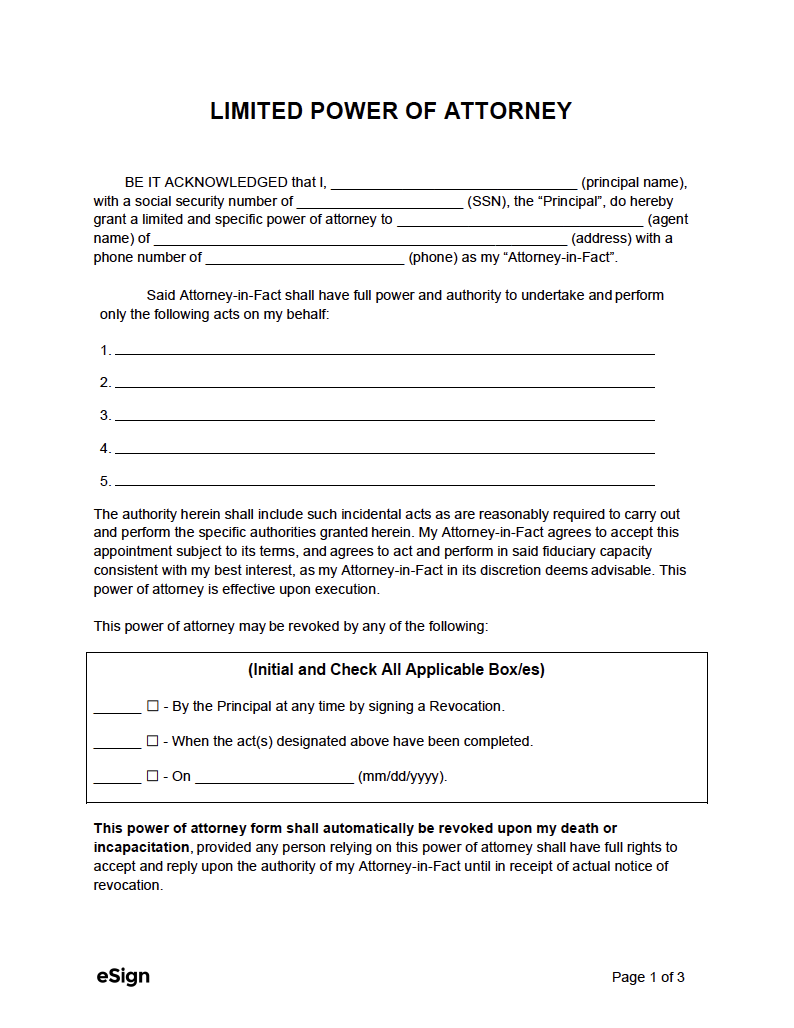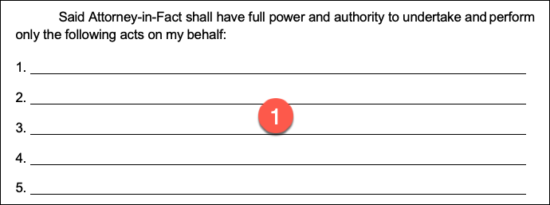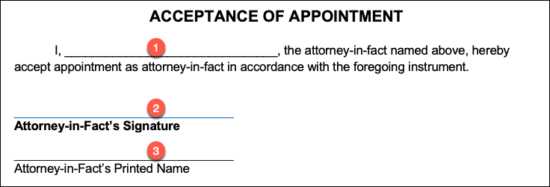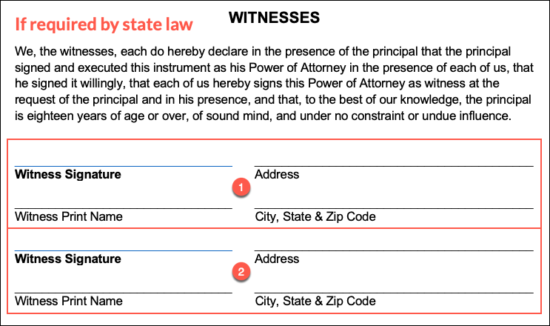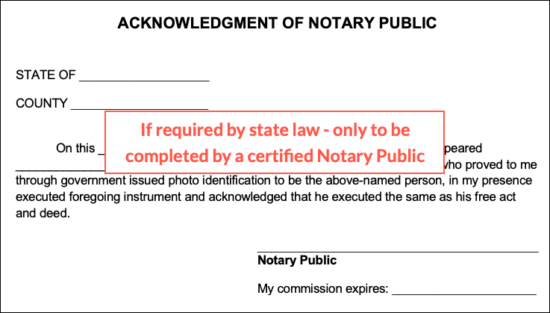A limited power of attorney form allows someone else (the “agent”) to step in for a specific activity on behalf of another person (the “principal”). After the task has been completed, the form will either be voided by the principal or will become invalid after a certain date. This form is meant for temporary powers given to an agent (not long-term), and therefore is a non-durable document. LPOAs are valid for use in every state, although the laws regarding signing vary.
Also known as a:
- LPOA
- Special power of attorney
By State
- Alabama
- Alaska
- Arizona
- Arkansas
- California
- Colorado
- Connecticut
- Delaware
- Florida
- Georgia
- Hawaii
- Idaho
- Illinois
- Indiana
- Iowa
- Kansas
- Kentucky
- Louisiana
- Maine
- Maryland
- Massachusetts
- Michigan
- Minnesota
- Mississippi
- Missouri
- Montana
- Nebraska
- Nevada
- New Hampshire
- New Jersey
- New Mexico
- New York
- North Carolina
- North Dakota
- Ohio
- Oklahoma
- Oregon
- Pennsylvania
- Rhode Island
- South Carolina
- South Dakota
- Tennessee
- Texas
- Utah
- Vermont
- Virginia
- Washington
- West Virginia
- Wisconsin
- Wyoming
Contents |
What is a Limited Power of Attorney?
A limited power of attorney is a document that gives another person permission to handle specific tasks for a fixed period of time. Also known as a “special” power of attorney, the designation is commonly executed for a one-time use. This form must be signed in accordance with the durable signing requirements in the state where the POA will be used.
Common Uses
- Check (writing)
- Management
- Minor (Child)
- Real Estate
- Single Transaction ($)
- Vehicle (buying or selling)
Sample
- Download (Blank): PDF, Word (.docx), OpenDocument
- Download (Sample Data): PDF, Word (.docx), OpenDocument
LIMITED POWER OF ATTORNEY
BE IT ACKNOWLEDGED that I, [PRINCIPAL NAME], with a social security number of [#], the “Principal”, do hereby grant a limited and specific power of attorney to [AGENT NAME] of [AGENT ADDRESS] with a phone number of [AGENT PHONE NUMBER] as my “Attorney-in-Fact”.
Said Attorney-in-Fact shall have full power and authority to undertake and perform only the following acts on my behalf:
- [DESCRIBE POWER]
- [DESCRIBE POWER]
- [DESCRIBE POWER]
- [DESCRIBE POWER]
- [DESCRIBE POWER]
The authority herein shall include such incidental acts as are reasonably required to carry out and perform the specific authorities granted herein. My Attorney-in-Fact agrees to accept this appointment subject to its terms and agrees to act and perform in said fiduciary capacity consistent with my best interest, as my Attorney-in-Fact, in its discretion deems advisable. This power of attorney is effective upon execution.
This power of attorney may be revoked by any of the following: (initial and check applicable box(es))
[INITIALS] ☐ – By the Principal at any time by signing a Revocation.
[INITIALS] ☐ – When the act(s) designated above have been completed.
[INITIALS] ☐ – On [MM/DD/YYYY].
This power of attorney form shall automatically be revoked upon my death or incapacitation, provided any person relying on this power of attorney shall have full rights to accept and reply upon the authority of my Attorney-in-Fact until in receipt of actual notice of revocation.
This Power of Attorney is governed by the laws of the State of [STATE NAME].
Signed on [MM/DD/YYYY].
________________________________
Principal’s Signature
[PRINCIPAL PRINTED NAME]
Principal Name
ACCEPTANCE OF APPOINTMENT
I, [ATTORNEY-IN-FACT NAME], the attorney-in-fact named above, hereby accept appointment as attorney-in-fact in accordance with the foregoing instrument.
________________________________
Attorney-in-Fact’s Signature
[ATTORNEY-IN-FACT PRINTED NAME]
Attorney-in-Fact Name
WITNESSES
We, the witnesses, each do hereby declare in the presence of the principal that the principal signed and executed this instrument as his Power of Attorney in the presence of each of us, that he signed it willingly, that each of us hereby signs this Power of Attorney as witness at the request of the principal and in his presence, and that, to the best of our knowledge, the principal is eighteen years of age or over, of sound mind, and under no constraint or undue influence.
________________________________
Witness Signature
[WITNESS NAME]
Witness Name
[WITNESS ADDRESS]
Witness Address
________________________________
Witness Signature
[WITNESS NAME]
Witness Name
[WITNESS ADDRESS]
Witness Address
ACKNOWLEDGMENT OF NOTARY PUBLIC
STATE OF [STATE]
COUNTY [COUNTY]
On [MM/DD/YYYY], before me appeared [PRINCIPAL NAME], as Principal of this Power of Attorney, who proved to me through government-issued photo identification to be the above-named person, in my presence executed the foregoing instrument and acknowledged that he executed the same as his free act and deed.
_________________________________________
Notary Public
My commission expires: [EXPIRATION]
How to Get a Limited Power of Attorney
Getting a limited power of attorney is as simple as selecting an agent, signing it in accordance with state laws, and giving a copy of the document to the agent. Afterward, the agent may sign on behalf of the principal as long as they present the power of attorney document upon request.
Step 1 – Decide the Powers to Give
The principal must decide the power(s) they would like to give to the agent. The powers cannot relate to health care decisions. Possible powers include receiving mail, managing real estate, signing a document, and so on.
Step 2 – Select the Agent
Also known as an “Attorney-in-Fact,” the agent is the person that will have the authorization to handle requests on the principal’s behalf. Due to the limited scope of responsibilities, the principal does not have to worry about the agent’s negligence. This is more of a concern with a durable power of attorney, which remains valid even if the principal becomes incapacitated. The principal usually chooses a person they know well and trust completely, which may be any of the following individuals:
- Family member (spouse, child, etc.)
- Close friend
- Trusted professional
Step 3 – Complete the Form
When it comes time to create the form, it’s best to use the state-specific forms. Most often, this is a statutory form that does not contain durable provisions and requires the principal to enter the agent’s specific powers and instructions onto the form.
Expiration date – Most limited power of attorney documents have an expiration date or an event that triggers the revocation of the form.
Step 4 – Sign It
In most states, a limited power of attorney must be signed in accordance with the laws pertaining to a durable POA. Therefore, it’s best to review the signing requirements for the principal’s state; typically, a notary public and witnesses must observe the signing of the document for it to be valid.
Step 5 – Use the Power of Attorney
Once signed by all required parties, a copy of the LPOA should be given to the agent(s). To perform the duties they were assigned, they may need to present the LPOA to an official entity. For example, if the agent is tasked with selling an automobile, the state DMV will require the agent to display the LPOA before signing over the title.
Instructions (How to Write)
Step 1 – Principal + Agent Info
At the top of the page, enter the following information:
- Name of the person completing the form (the principal).
- Principal’s social security number (8 digits).
- Name of the agent (the person acting on behalf of the principal).
- Agent’s full street address.
- Phone number (#) of the agent (preferably cell phone).
Step 2 – Power(s) Granted
In the second section of the form, list any and all actions the agent will be authorized to perform on behalf of the principal. If more lines are needed, the principal can attach an additional form (be sure to note the attachment of an additional form on one of the five (5) lines provided).
Step 3 – Means of Revocation
This section allows the principal to specify how the LPOA will be terminated. Any number of boxes can be selected, and the principal will need to inscribe their initials next to the box(es) selected.
Step 4 – Principal’s Signature
The principal will need to provide the following information:
- The state in which the agent will be carrying out duties for the principal.
- Date (day, month, and year) on which the LPOA will go into effect.
- Signature of the principal (can be written by hand or by using eSign).
- Printed full name of the principal.
Step 5 – Agent’s Signature
As confirmation that they understand their duties, the agent will need to enter the following information:
- Their printed name (can be written by principal OR agent).
- Their signature (eSignatures are OK).
- Their full printed name.
Step 6 – Witness Signature(s)
If required by state law, the principal may need to have up to two (2) witnesses verify their signature onto the LPOA. Each witness will need to include the following:
- Their signature.
- Their printed name.
- Address (street, city, state, and ZIP).
Step 7 – Notarization
The principal may be required by state law to have the form notarized. Alternatively, they can opt to have it notarized even if it isn’t a requirement to increase the legitimacy of the LPOA. The section on the last page is to be completed by a Notary Public only.
